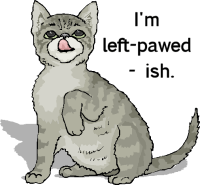Are cats left or right pawed?

By and large, humans are right-handed. There is a very small percentage (i.e. just under 1%) who are both right and left-handed – that is, ambidextrous. However, 'ambidextrous' means having 'two right hands' so this rather proves the point. This leaves a lonely 10% of the human race who are mostly or exclusively left-handed.
For humans this matters, as you will be assured any leftie who has grappled with right-handed tin openers, scissors and other even more complex tools. Then humans who are also cat owners started asking themselves – what about cats? Are they also naturally right-handed, er... pawed?
For cats the matter is relatively trivial, because mice are not designed to be operated on by a particular paw, and cat flaps can be operated by judicious pressure with the head. As long as a cat can belt a sleeping human across the nose to get that human up and serving breakfast, does it matter which paw is used?
Well, it certainly mattered to some cats, because in the last century bands of dedicated researchers sliced, diced and otherwise mistreated cat brains to see if this had any effect on which paw preference their unfortunate subjects developed. Research continues today, but tends to be humane observational studies rather than the misguided barbarism of before.
To date the results have been mixed. (As are the results of almost every experiment about cat behaviour. Cats have an outstanding ability to frustrate and infuriate researchers because cat behaviour tends to vary depending on the individual cat, and on the mood that individual cat is in on a given day.)
Basically when it comes to the everyday behaviour of a cat, left or right paw seems to be mainly a matter of convenience. When you need to slap a mosquito, you would use whichever hand is best aligned with the body part the mosquito is about to dine upon. In the same way cats tend to use whichever paw (or set of claws) is already optimally positioned for the job on hand.
However, when the task gets a bit more complex – for example, stepping off a table to a more distant window ledge, or digging the last bit of tuna from the bottom of a deep tin – then a paw preference becomes noticeable. By and large a cat will lead off with the same paw, or use the same paw for a complex task. Which brings us back to the question- are cats right-or left pawed?
After multiple studies and learned academic papers, science has come up with the simple answer that there's pretty much a 50/50 split. But it's not a random split. Of cats that expressed a preference for left-pawedness, the majority were male. Female cats tend to be right-pawed. There's a substantial minority of cats that don't fit this profile. Many male cats are right pawed, while others keep up the tradition of driving researchers crazy by being left-pawed most of the week, but right-pawed on alternate Mondays and Thursdays. (Or some similar eccentricity.)
Nevertheless, the fact that toms and queens have a statistical preference for different paws has led some researchers to wonder if there is a hormonal component involved. They note that cats with a more established paw preference tend to have more stable characters (though what counts as 'stable' with some oriental breeds is an open question.) However, the entire field of research has been plagued by the fact that most researchers can only study a small sample pool of cats and there is so much variation between individual cats that gender-based temperament is barely relevant.
For example what kind of 'cat' are we talking about? Anything one observes about a Ragdoll will have little relevance for an exotic Cerval cross, let alone whether one or the other of these cats is neutered, living in a multi-cat household, well socialized or any of the dozens of other variables that make each cat a unique character - with right or left-pawedness being just one of those variables. Working out if left-handed cats have a higher Feline Temperament Profile (yes, that's a scientific index) might be as relevant as working out if blue-eyed humans get more irritable in traffic jams.
Also it might be that cats that are normal, and it is humans that are aberrant. As we pointed out earlier, it is a rare left-handed human who does not have to develop a degree of ambidexterity to cope in a right-handed world. In some human societies, members face considerable social pressure to be, or become right-handed. Note that the Latin for 'left' is 'sinister', which tells you all you need to know about human suspicion of anyone who is different.
Rural agricultural societies put particular pressure on girls, to the extent that anthropologists have described several tribes where left-handed women just do not exist. Yet among most humans there is no gender bias for right or left-handedness. In other words, humans worry about the relevance of right-or left handedness, because it's significant for humans.
Cats don't have to worry if a tin opener is right or left-handed, because they use humans as tin openers. For them using a right or left paw is a matter of spontaneous choice and convenience. It may be that for cats, which paw they prefer is less a matter of brain wiring and more one of simple habit.
